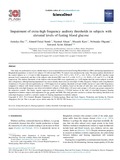Impairment of extra-high frequency auditory thresholds in subjects with elevated levels of fasting blood glucose
Date
2018-03-13Publisher
Science DirectAuthor
Das, AnindyaSumit, Ahmed Faisal
Ahsan, Nazmul
Kato, Masashi
Ohgami, Nobutaka
Akhand, Anwarul Azim
Metadata
Show full item recordCitation
Das, A., Sumit, A. F., Ahsan, N., Kato, M., Ohgami, N., & Akhand, A. A. (2018). Impairment of extra-high frequency auditory thresholds in subjects with elevated levels of fasting blood glucose. Journal of Otology, 13(1), 29-35. doi:10.1016/j.joto.2017.10.003Abstract
This study was performed to assess whether there is an association between elevated Fasting Blood Glucose (FBG) and hearing impairment in Bangladeshi population. A total of 142 subjects (72 with elevated FBG; 70 control) were included in the study. The mean auditory thresholds of the control subjects at 1, 4, 8 and 12 kHz frequencies were 6.35 ± 0.35, 10.07 ± 0.91, 27.57 ± 1.82, 51.28 ± 3.01 dB SPL (decibel sound pressure level), respectively and that of the subjects with elevated FBG were 8.33 ± 0.66, 14.37 ± 1.14, 38.96 ± 2.23, and 71.11 ± 2.96 dB, respectively. The auditory thresholds of the subjects with elevated FBG were significantly (p < 0.05) higher than the control subjects at all the above frequencies, although hearing impairment was most evidently observed at an extra-high (12 kHz) frequency. Subjects with a long duration of diabetes (>10 years) showed significantly (p < 0.05) higher level of auditory thresholds at 8 and 12 kHz, but not at 1 and 4 kHz frequencies, compared to subjects with shorter duration of diabetes (≤10 years). In addition, based on the data of odds ratio, more acute impairment of hearing at the extra-high frequency was observed in diabetic subjects of both older (>40 years) and younger (≤40 years) age groups compared to the respective controls. The binary logistic regression analysis showed a 5.79-fold increase in the odds of extra-high frequency hearing impairment in diabetic subjects after adjustment for age, gender and BMI. This study provides conclusive evidence that auditory threshold at an extra-high frequency could be a sensitive marker for hearing impairment in diabetic subjects.

